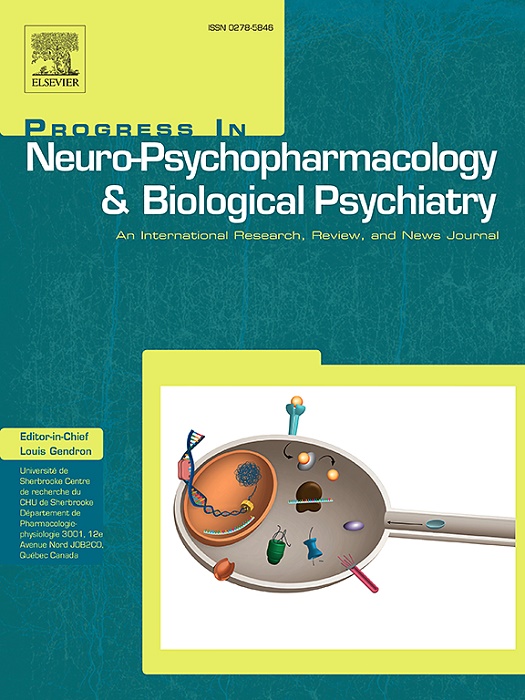诊断信息的神经亚型显示自闭症谱系障碍的亚组具有可靠和独特的功能连接概况。
IF 3.9
2区 医学
Q1 CLINICAL NEUROLOGY
Progress in Neuro-Psychopharmacology & Biological Psychiatry
Pub Date : 2025-07-16
DOI:10.1016/j.pnpbp.2025.111452
引用次数: 0
摘要
背景:自闭症谱系障碍(ASD)是一种复杂的神经发育障碍,其症状和神经生物学特征具有异质性,这阻碍了可靠生物标志物的识别。直到最近,出现了ASD神经分型来检测每个亚组的神经特征。方法:采用半监督聚类、异质性判别分析(HYDRA)方法,在ASD/对照标记信息的指导下,结合高维输入特征的多尺度降维方法,对ASD进行神经亚型分型。从约2000个受试者的大数据集中估计了功能连接作为分型受试者的神经特征。对聚类性能进行了系统评价,并将半监督方法与结合不同类型特征约简方法的无监督K-means方法进行了比较。结果:我们成功地检测到两个集群,超连接亚型和低连接亚型,每个集群在大型网络之间和内部表现出不同的连接模式,具有高可靠性。与无监督聚类方法相比,半监督聚类方法表现出更好的性能。我们观察到功能连通性的集群效应,例如,超连通性集群显示主要大型网络内部的超连通性和网络之间的超/低连通性,例如默认模式与注意网络之间的超连通性,默认模式与视觉/听觉网络之间的低连通性。相反,低连通性集群显示相反的连通性模式。此外,我们发现不同亚型的ASD的连通性和主要症状之间存在不同的相关性。结论:我们的研究结果表明,半监督方法有可能将ASD亚型划分为不同且可靠的集群。该聚类基于功能连接模式有效区分异质神经标记物,同时在每个亚型之间建立不同的神经行为关系,这是未来制定个性化诊断和治疗策略的关键一步。本文章由计算机程序翻译,如有差异,请以英文原文为准。
Diagnosis-informed neuro-subtyping reveals subgroups of autism spectrum disorder with reliable and distinct functional connectivity profiles
Background
Autism Spectrum Disorder (ASD) is a complex neurodevelopmental disorder characterized by heterogeneous symptoms and neurobiological features, which hinders the identification of reliable biomarkers. Until recently, ASD neuro-subtyping has emerged to detect neural features in each subgroup.
Methods
We implemented neuro-subtyping of ASD using a semi-supervised clustering method, HeterogeneitY through DiscRiminative Analysis (HYDRA), guided by the labeling information of ASD/controls, together with a multi-scale dimension reduction method of high-dimensional input features. Functional connectivity was estimated as neural features for subtyping subjects from a large dataset with ∼2000 subjects. Systematic evaluation of clustering performance was conducted and the semi-supervised approach was compared with unsupervised K-means, commonly used for neuro-subtyping, combined with different types of feature reduction methods.
Results
We successfully detected two clusters, the hyper-connectivity subtype and hypo-connectivity subtype, each exhibiting distinct connectivity patterns between and within large networks, with high reliability. The semi-supervised clustering approach demonstrated superior performance compared to the unsupervised approach. We observed cluster effect on functional connectivities, for instance, the hyper-connectivity cluster shows hyper-connectivity within major large networks and hyper/hypo-connectivities between networks, such as hyper-connectivity between default mode and attention networks, and hypo-connectivity between default mode and visual/auditory networks. In contrast, the hypo-connectivity cluster displayed the opposite connectivity patterns. Furthermore, we found varying correlations between connectivities and main symptoms of ASD across subtypes.
Conclusions
Our findings indicate that the semi-supervised approach has the potential to subtype ASD into distinct and reliable clusters. The clusters effectively differentiate heterogeneous neural markers based on functional connectivity patterns, meanwhile establish distinct neurobehavioral relationships across each subtype, which is a critical step towards developing individualized diagnosis and treatment strategies in the future.
求助全文
通过发布文献求助,成功后即可免费获取论文全文。
去求助
来源期刊
CiteScore
12.00
自引率
1.80%
发文量
153
审稿时长
56 days
期刊介绍:
Progress in Neuro-Psychopharmacology & Biological Psychiatry is an international and multidisciplinary journal which aims to ensure the rapid publication of authoritative reviews and research papers dealing with experimental and clinical aspects of neuro-psychopharmacology and biological psychiatry. Issues of the journal are regularly devoted wholly in or in part to a topical subject.
Progress in Neuro-Psychopharmacology & Biological Psychiatry does not publish work on the actions of biological extracts unless the pharmacological active molecular substrate and/or specific receptor binding properties of the extract compounds are elucidated.

 求助内容:
求助内容: 应助结果提醒方式:
应助结果提醒方式:


